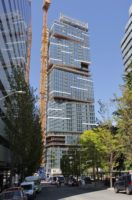Here, the columnist discusses the wide-ranging impacts that can be felt by numerous parties once a developer of a condominium project starts to enter into bankruptcy.

MORMAN
Today’s distressed real estate market does not discriminate when it comes to claiming victims. A particularly onerous situation occurs when a condominium developer becomes insolvent and is unable to pay its bills. This causes a wave of financial impact that can adversely affect mortgage lenders, contractors and their subs, buyers under contract and unit owners.
Often, the worst situation arises when a lender forecloses and the developer fails to file for bankruptcy. The failure to file for bankruptcy protection can be indicative of a project that is so far completely underwater that there simply is no money leftover for anybody.
In such cases, contractors who filed construction liens will most likely see them completely wiped out by the foreclosure. Buyers under contract are in limbo. If they close, they buy into a development that has substantial problems. If they do not close, they risk losing their deposits. Individual unit owners face the likelihood that the foreclosing lender will make, at most, limited maintenance payments, depending on the law of the jurisdiction where the development is located. In such situations, common areas can go into disarray, and unit owners are left with condominiums with substantially depressed values.
The case of a condominium developer that files for bankruptcy is not so pretty, either. True, such a developer, at the very least, has the resources to cover the expenses of a bankruptcy filing. Also true is that when such bankruptcies are filed, there sometimes is equity leftover in the project. This equity can sometimes be sufficient to pay off construction liens—although lienors will often be limited by the bankruptcy stay in their ability to foreclose.
However, to the extent that a contractor would otherwise be entitled to file a lien before the bankruptcy, but has not yet done so, the bankruptcy code does provide that in many instances, the contractor will be able to file its lien after the bankruptcy was filed. As well, the bankruptcy code affords certain benefits persons to such as materialmen who sell the debtor goods within 20 days preceding the bankruptcy filing, and those persons who provide goods and services after the bankruptcy filing.
Such persons are entitled to top priority “administrative claims.” If there is money in the bankruptcy estate, persons who hold administrative claims often receive payment equal to 100 cents on the dollar. Also, to the extent a construction or mechanic’s lien on the property is valid, if there is money generated, e.g., from the sale of units, often such money can be used to pay down the liens if there is equity in the property.
As for buyers under contract who have not closed, the courts often handle these situations on a case-by-case basis. If the buyer presents a compelling case to the court why he or she should be able to back out of a contract, there is a possibility that the buyer may be able to obtain a court order requiring a refund of some or all of the deposit monies. For unit owners, a developer bankruptcy provides opportunities to present their grievances before a bankruptcy judge—albeit with mixed results.
At the end of the day, once a condominium developer begins to experience financial distress, the effect can ripple out like waves from a stone thrown in a pond. While sometimes parties are better off before a bankruptcy judge than in a state court foreclosure proceeding, the ramifications of such a developer’s insolvency are usually widely felt, and are infrequently resolved to the satisfaction of those impacted.



Post a comment to this article
Report Abusive Comment